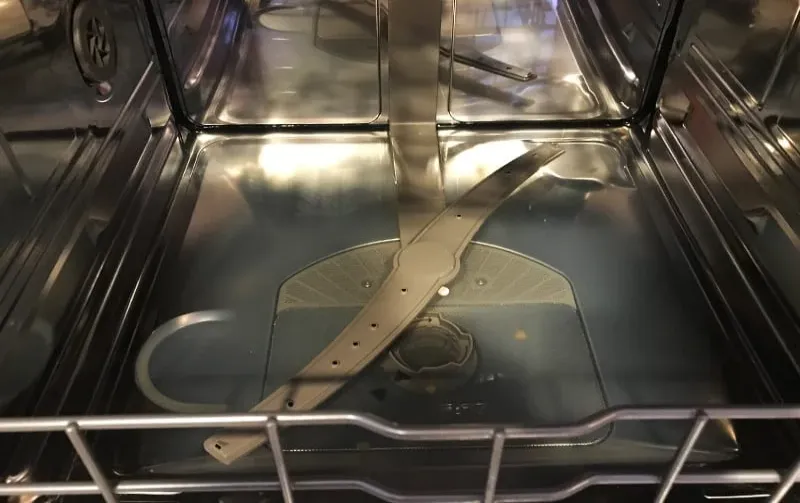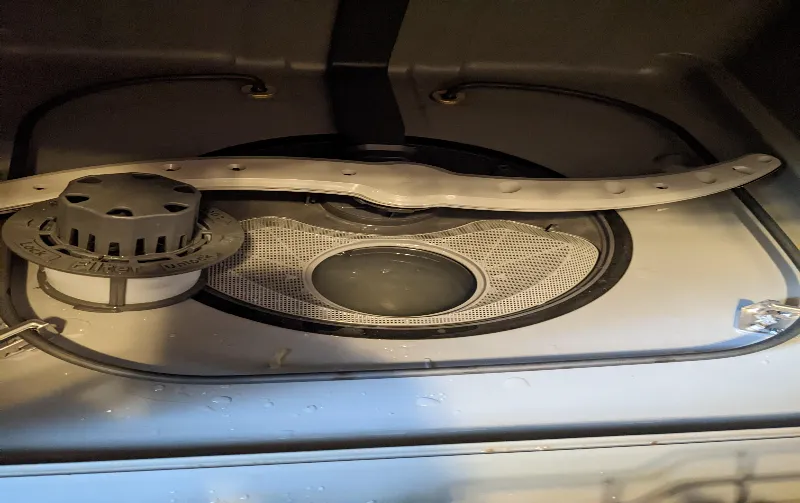Running your dishwasher with standing water inside is not advisable. It can indicate a drainage problem that needs addressing.
Running a dishwasher is a common household task aimed at simplifying kitchen clean-up, but if you notice standing water at the bottom of your dishwasher, it’s a sign something is amiss.
Standing water can lead to mold growth and unpleasant odors and potentially damage your dishwasher’s internal components.
Proper maintenance and troubleshooting can prevent these issues and extend the life of your appliance.
Ensuring your dishwasher is in proper working order not only keeps your dishes clean but also maintains the hygiene of your kitchen environment.
Addressing the standing water promptly can save you from costly repairs and keep your dishwasher running efficiently for years to come.
Remember, regular checks for blockages and malfunctions are essential for optimal dishwasher performance.

Understanding Dishwasher Functions
Welcome to a deeper understanding of one of the most convenient appliances in your kitchen: the dishwasher.
In order to effectively address any issues, such as standing water at the bottom, it’s essential to know the basics of how your dishwasher works.
This knowledge will also guide you in maintaining and using your dishwasher correctly, ensuring its longevity and optimal performance.
How Does A Dishwasher Work?
A dishwasher is designed to streamline the task of cleaning dishes, employing a combination of water, heat, and detergents to wash away food particles and sanitize your kitchenware.
Here’s a simplified breakdown of the dishwasher’s cycle:
- Water enters the machine through the water inlet valve.
- The water is heated to an appropriate temperature to dissolve detergent and ensure sanitization.
- The dishwasher releases detergent into the dishwasher’s chamber.
- Nozzles on the spray arms pump out the hot water-detergent mixture, reaching all surfaces of the loaded dishes.
- Following the wash and rinse cycles, the dirty water is pumped out and fresh water is brought in for a final rinse.
- Many dishwashers have a drying function that circulates hot air or uses a heated rinse to evaporate the remaining moisture.
Any disruption in this process might lead to problems, such as standing water, which indicates a possible malfunction.
Effect Of Standing Water On Dishwasher Functionality
Standing water in the bottom of your dishwasher is a clear sign that the appliance is not functioning as intended.
The most common reasons for water not draining include blockages in the filter or drain hose, a malfunctioning pump, or problems with the electronic systems.
Left unaddressed, this stagnant water can lead to:
- Trapped food particles and standing water can become a breeding ground for bacteria, resulting in unpleasant smells.
- The growth of bacteria and mold poses potential health risks.
- Continuous exposure to stagnant water could damage the appliances and dishes over time.
Before running a cycle with standing water present, identify and resolve the underlying issue to prevent further damage and ensure your dishwasher runs efficiently.
Risks And Consequences
Discovering standing water in a dishwasher poses challenges that extend beyond inconvenience.
There are significant risks and consequences associated with running a dishwasher in such a condition.
A keen understanding of these potential hazards is crucial to maintaining the longevity of the appliance and ensuring personal safety.
Here’s what every homeowner should consider before deciding to operate a dishwasher with standing water.
Potential Damage To Dishwasher Components
Running a dishwasher with standing water can lead to serious component damage. Water that remains stagnant can create multiple issues:
- Stress on the dishwasher’s motor as it struggles to pump out the excess water, reducing its lifespan.
- Corrosion of metal parts and deterioration of seals, causing leaks and operational failures.
- Impairment of the heating element, which could result in inefficient cleaning or a total breakdown.
Critically, water should be removed before commencing a new wash cycle to prevent these problems from escalating.
Health And Safety Concerns
Health risks associated with stagnant water cannot be overlooked. The following list highlights the safety concerns:
- Stagnant water is a breeding ground for bacteria, including harmful strains like E. coli or Salmonella, that can contaminate dishes.
- Damp environments encourage mold and mildew growth, possibly triggering allergies or respiratory issues.
- Water in unwanted places could lead to an electrical malfunction, posing a risk of shock upon operation.
Ensuring that all standing water is adequately managed reinforces a safe kitchen environment and adheres to hygiene standards.
Troubleshooting And Solutions
Troubleshooting your dishwasher for issues such as standing water can seem daunting.
Rest assured, many times, the solution is within reach and doesn’t necessarily require professional intervention.
With a strategic approach to diagnosing and fixing the problem, you can get your dishwasher back in working order.
Below are steps and insights aimed at helping you hone in on the problem and implement the most effective solutions.
Steps To Address Standing Water In The Dishwasher
Sometimes, fixing standing water in your dishwasher is a straightforward process.
Follow these steps cautiously to resolve the issue:
- First, ensure your dishwasher is off and unplugged for safety.
- Next, remove any dishes and the bottom dish rack to provide clear access to the dishwasher’s basin.
- Check for food particles, glass, or other debris that might be clogging the drain. Remove any obstructions you find.
- Inspect the drain hose for kinks or blockages. Straighten the hose if kinked or remove any blockage if present.
- Utilize a plunger or a commercial drain cleaner to clear the blockage, or consider a mixture of vinegar and baking soda for a natural alternative.
- If these efforts fail to resolve the issue, it may be time to examine the drain pump or filter, which could be clogged or malfunctioning.
- Contact a professional if troubleshooting doesn’t solve the problem.
Common Causes Of Standing Water
Identifying the root cause is essential for fixing the problem of standing water. Below is a table highlighting common causes:
| Cause | Possible Issue | Solution |
|---|---|---|
| Clogged Drain | Debris accumulation blocking water flow | Clean drain manually or use a plunger/drain cleaner |
| Faulty Drain Pump | Pump not ejecting water properly | Check for obstructions or consider pump replacement |
| Blocked Drain Hose | Hose kinked or clogged, preventing water egress | Straighten hose or clean to remove blockage |
| Garbage Disposal Blockage | Improper installation or clogged disposal | Ensure proper installation and clear any blockages |
| Filter Issues | Dirty or incorrectly installed filter | Clean or reinstall filter correctly |

Maintenance Tips
Ensuring your dishwasher runs efficiently involves a bit of know-how and regular upkeep.
Maintenance isn’t just about fixing problems as they arise; it’s preventative care to avoid issues like standing water, which can be a breeding ground for bacteria and foul odors.
Let’s take a deep dive into keeping your dishwasher in tip-top shape and preventing unnecessary service calls or replacements.
Preventing Standing Water In Your Dishwasher
Standing water at the bottom of your dishwasher is often a sign of a drainage problem.
It can lead to unpleasant smells and potentially damage your machine. To prevent this issue:
- Check and clean the filter regularly to prevent food particles from clogging the drainage system.
- Ensure the garbage disposal is clear, as blockages can impede water flow from the dishwasher.
- Run hot water in your sink before starting the dishwasher; this ensures the environment is conducive for effective drainage.
- Inspect the dishwasher hoses for any kinks or blockages that may prevent water from draining properly.
Regular Maintenance Practices
Regular maintenance drastically reduces the risk of malfunctions and extends the lifespan of your dishwasher.
Here are key practices to follow:
- Clean the spray arms to ensure they are not blocked by debris, which can affect water circulation.
- Wipe down the gaskets and seals regularly to maintain a tight seal and prevent leaks.
- Use the right detergent in the appropriate amount, as excess can cause residue buildup.
- Schedule a professional inspection annually for a comprehensive check-up.
Proactive attention to these areas will keep your dishwasher running smoothly and forestall the inconvenience and expense of emergency repairs.
Professional Assistance
Encountering standing water in the dishwasher can be unsettling.
Often, simple troubleshooting can address the issue, but there are times when it’s wise to seek the expertise of a professional.
Recognizing when to call in a specialist can not only save your dishwasher from further damage but also keep you safe from any water-related hazards.
When To Seek Professional Help
It’s important to know the signs that indicate a need for professional intervention:
- If water persists after you’ve manually emptied the dishwasher and cleaned the filter, there’s an underlying issue that requires expert diagnosis.
- Unusual sounds or error codes flashing on the display panel are telltale signs of malfunction.
- Water leaking onto the floor suggests a potential leakage or pump problem.
- Water should not remain post-cycle; a blockage or pump failure could be the culprit.
- Should the dishwasher stop mid-cycle or fail to start, electrical issues may be at play.
Hiring A Dishwasher Repair Specialist
If you’ve established that DIY remedies will not suffice, the next step is to hire a qualified dishwasher repair specialist. Carefully consider these pointers:
- Seek recommendations from friends or check online reviews for top-rated local technicians.
- Verify their qualifications, certification, and experience with your dishwasher’s brand and model.
- Ensure they provide a transparent quote and a warranty for their services.
- Ask about the estimated time frame for the repair.
- Lastly, opt for a repair service that offers a thorough post-repair check to ensure the problem is entirely resolved.
Frequently Asked Questions Of Can I Run My Dishwasher With Standing Water
Is Standing Water In Dishwasher Safe?
Standing water in the dishwasher can be unsafe, as it may indicate a clog or malfunction that needs attention to prevent overflow or water damage.
Can Dishwashers Operate With Water Inside?
Operating a dishwasher with standing water inside isn’t recommended; properly troubleshooting and addressing the issue is essential before running a cycle.
Why Does Water Remain In Dishwasher?
Water often remains in a dishwasher due to blockages in the filter or drain hose, or problems with the pump, necessitating a thorough check and cleaning.
How To Fix A Dishwasher With Water Leftover?
Remove standing water with a cup or towel, clean filters, and check the drain hose for clogs.
Conclusion
Running your dishwasher with standing water isn’t advisable. It’s essential to tackle the cause before using the appliance.
Clearing blockages and ensuring proper maintenance will prevent damage and keep your dishwasher functioning effectively.
Always prioritize safety and efficiency for the best dishwashing experience.
